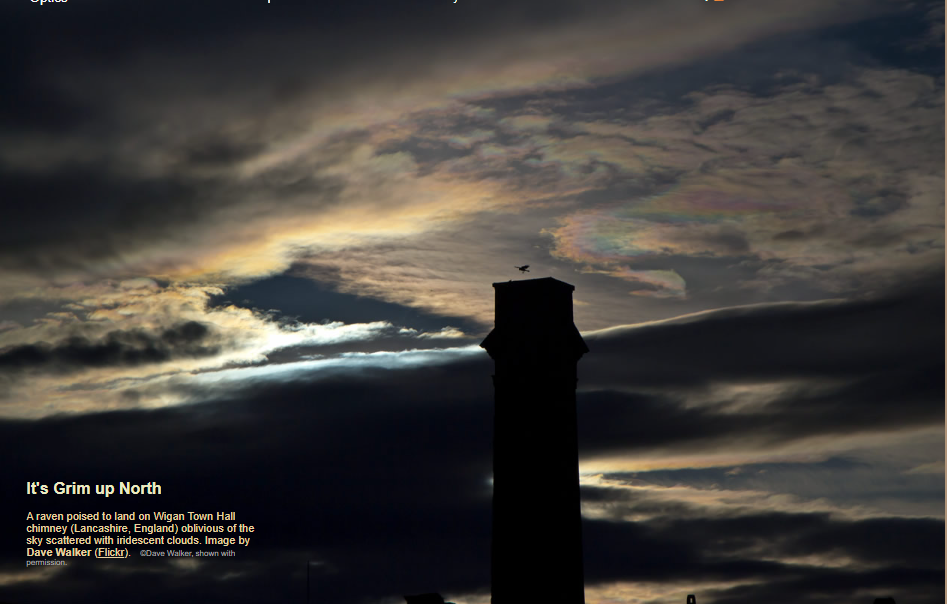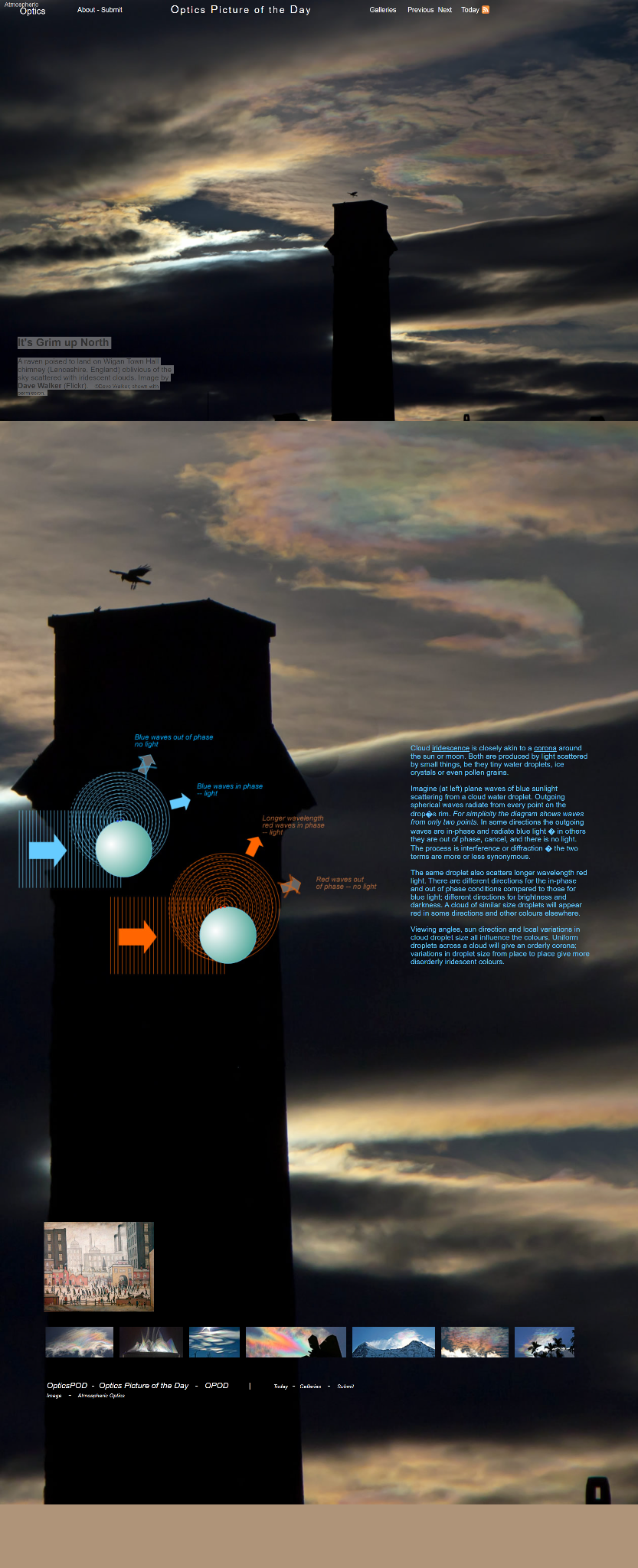OPOD - Iridescence, Raven, Wigan
OPOD - Iridescence, Raven, Wigan: A Mesmerizing Display of Color in the Sky
The skies above Wigan Town Hall in Lancashire, England, were adorned with a captivating sight - a raven gracefully perched on the chimney, seemingly unaware of the iridescent clouds scattered across the sky. This mesmerizing phenomenon, known as cloud iridescence, bears a striking resemblance to the corona that surrounds the sun or moon. Both are created by the scattering of light by small particles such as water droplets, ice crystals, or even pollen grains.
To understand the intricate dance of colors within these iridescent clouds, let's imagine the interaction between sunlight and a cloud water droplet. As sunlight, composed of plane waves of blue light, encounters the droplet, outgoing spherical waves radiate from every point on the droplet's rim. In some directions, these outgoing waves align and amplify each other, resulting in the emission of vibrant blue light. However, in other directions, the waves interfere and cancel each other out, leading to darkness. This phenomenon, known as interference or diffraction, is responsible for the formation of the diverse colors observed in cloud iridescence.
It is important to note that the same droplet also scatters longer wavelength red light. However, the directions for in-phase and out-of-phase conditions differ from those of blue light, resulting in distinct brightness and darkness orientations. When numerous droplets of similar size populate a cloud, it exhibits a corona with orderly patterns of color. Conversely, variations in droplet size across different regions of the cloud give rise to a more chaotic and unpredictable display of iridescent colors.
Several factors influence the appearance of cloud iridescence. The viewing angles from which we observe these phenomena play a significant role. Additionally, the direction of the sun relative to the clouds, as well as local variations in droplet size, contribute to the unique color patterns we witness. It is the combination of these factors that creates the captivating spectacle of iridescent clouds in the sky.
Cloud iridescence serves as a reminder of the intricate and awe-inspiring nature of our atmosphere. These fleeting moments of vibrant colors suspended in the sky evoke a sense of wonder and appreciation for the beauty that surrounds us. Whether it's a raven perched atop a chimney or a solitary observer gazing upwards, these displays of iridescence never fail to captivate our imagination.
In conclusion, the enchanting phenomenon of cloud iridescence, exemplified by the raven and iridescent clouds above Wigan Town Hall, is a result of light scattering by small particles within the atmosphere. The interplay between sunlight, water droplets, and ice crystals gives rise to a kaleidoscope of colors that dance across the sky. As we continue to explore and understand atmospheric optics, let us revel in the breathtaking displays of iridescence that grace our world, reminding us of the remarkable wonders that exist just beyond our reach.

It's Grim up North
A raven poised to land on Wigan Town Hall chimney (Lancashire, England) oblivious of the sky scattered with iridescent clouds. Image by Dave Walker (Flickr). ©Dave Walker, shown with permission.

Cloud iridescence is closely akin to a corona around the sun or moon. Both are produced by light scattered by small things, be they tiny water droplets, ice crystals or even pollen grains.
Imagine (at left) plane waves of blue sunlight scattering from a cloud water droplet. Outgoing spherical waves radiate from every point on the drop�s rim. For simplicity the diagram shows waves from only two points. In some directions the outgoing waves are in-phase and radiate blue light � in others they are out of phase, cancel, and there is no light. The process is interference or diffraction � the two terms are more or less synonymous.
The same droplet also scatters longer wavelength red light. There are different directions for the in-phase and out of phase conditions compared to those for blue light; different directions for brightness and darkness. A cloud of similar size droplets will appear red in some directions and other colours elsewhere.
Viewing angles, sun direction and local variations in cloud droplet size all influence the colours. Uniform droplets across a cloud will give an orderly corona; variations in droplet size from place to place give more disorderly iridescent colours.
Note: this article has been automatically converted from the old site and may not appear as intended. You can find the original article here.
Reference Atmospheric Optics
If you use any of the definitions, information, or data presented on Atmospheric Optics, please copy the link or reference below to properly credit us as the reference source. Thank you!
-
<a href="https://atoptics.co.uk/blog/opod-iridescence-raven-wigan/">OPOD - Iridescence, Raven, Wigan</a>
-
"OPOD - Iridescence, Raven, Wigan". Atmospheric Optics. Accessed on November 26, 2024. https://atoptics.co.uk/blog/opod-iridescence-raven-wigan/.
-
"OPOD - Iridescence, Raven, Wigan". Atmospheric Optics, https://atoptics.co.uk/blog/opod-iridescence-raven-wigan/. Accessed 26 November, 2024
-
OPOD - Iridescence, Raven, Wigan. Atmospheric Optics. Retrieved from https://atoptics.co.uk/blog/opod-iridescence-raven-wigan/.